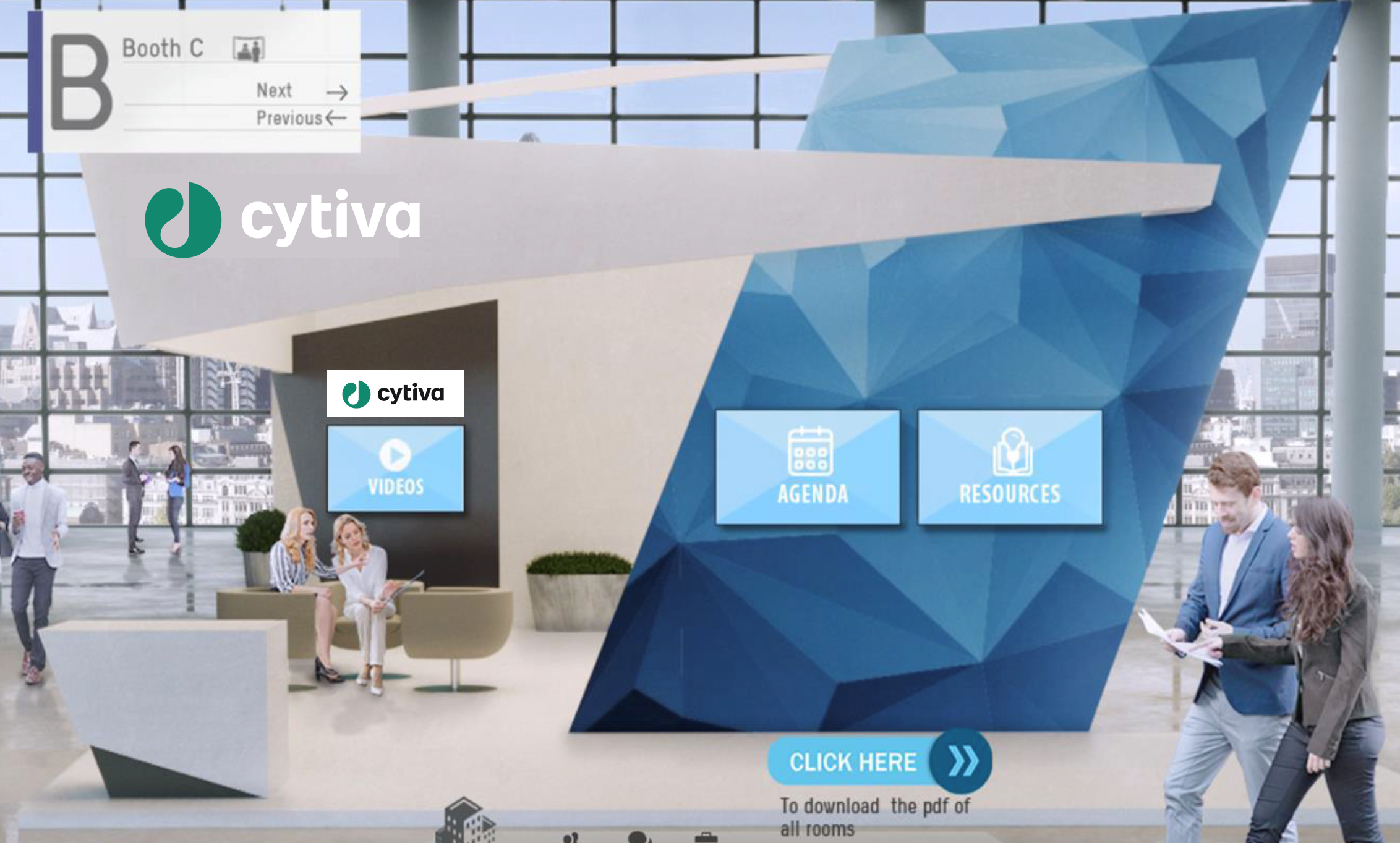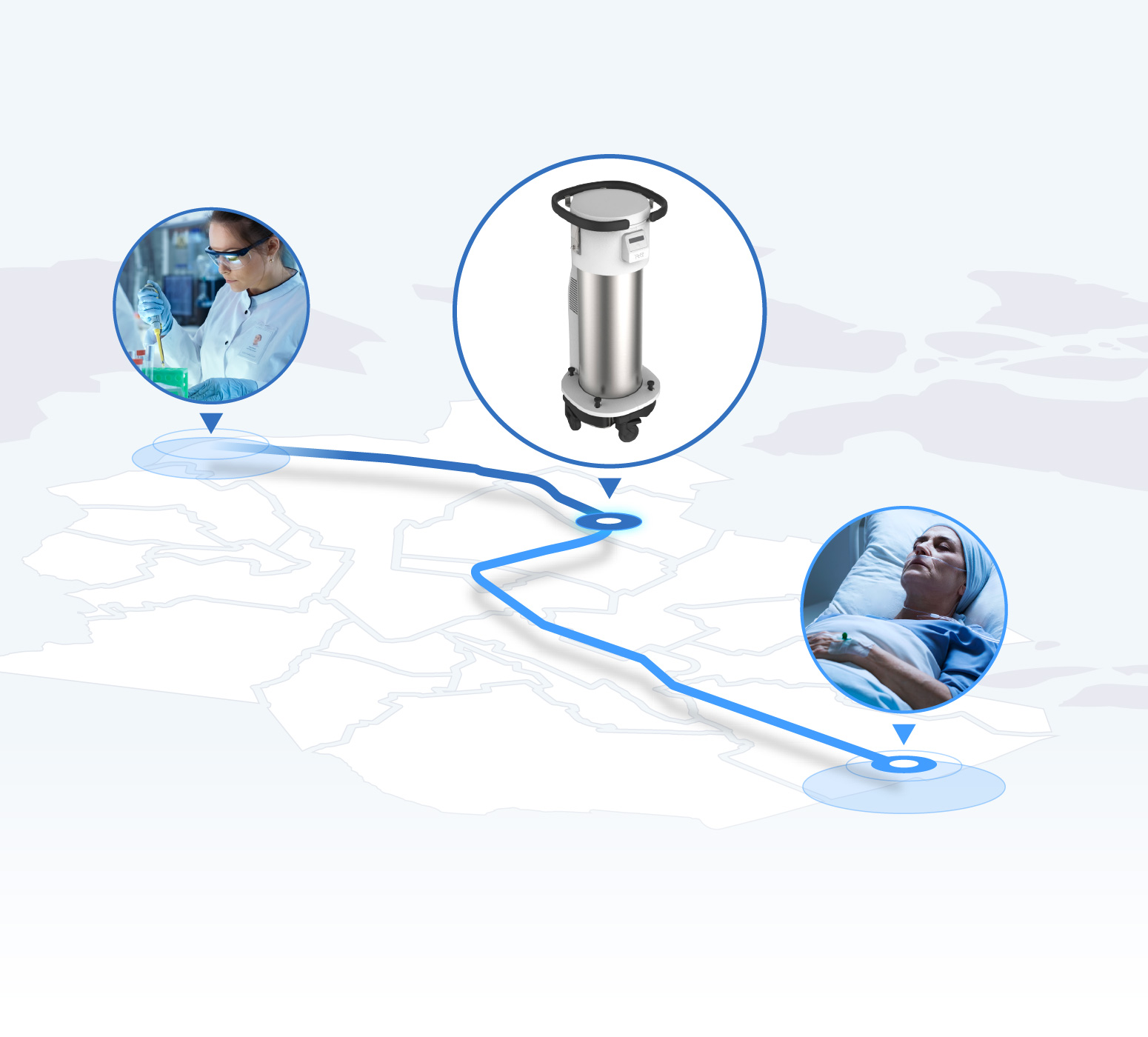A new way to ship and transport cellular materials puts patients front and center
It wasn’t Paris in Spring, but the annual meeting of the International Society of Cellular Therapy (ISCT) 2020 did happen in May, albeit virtually. From the comfort of their home office with snacks at the ready, attendees devoured sessions on some key topics of the day through a cool digital interface replete with avatars. If you weren’t there, Figure 1 offers a glimpse. Here are my highlights on a session that introduced a new way to ship and transport cellular materials, putting patients front and center.
Fig 1. Cytiva’s virtual booth at ISCT 2020.
Cell therapies begin and end with the patient
Patient centricity was a theme voiced by all the speakers. They noted that logistics is critical to the cell therapy workflow, because if a patient’s cell therapy doesn’t get there at the right time and in good shape, nothing else matters. Cytiva’s Alex Nancekievill cited feedback from cell therapy companies on the challenges they face with existing liquid nitrogen-based shipments. According to them, scheduling must be rigid to ensure that there is enough liquid nitrogen in the ‘dry shipper’ for door-to-door shipment. Shipments are put at risk if the manufacturing workflow is delayed, there is a transport hold-up, or the clinical site is not able to receive or manage the shipper. To mitigate the risk of running out of liquid nitrogen, which could lead to unacceptable warming of the sample inside, oversized shippers are used to add extra hold time.
Nancekievill introduced an alternative, the VIA Capsule system, which aims to change all this with features that extend beyond the logistics process right up to the patient in the clinic. More on this, after I show you the nuts and bolts of how the system works.
A modern way to ship cellular materials
Unveiled on-screen for the first time in this presentation, VIA Capsule is quite the futuristic system (Fig 2), its design matching the sleek look and feel of the conference itself.
Fig 2. The VIA Capsule shipment system in its charge configuration, with removable electrically powered cryocooler on top. The shipping unit is the lower section, below the black handle, with integrated smart monitor and retractable wheels.
Nancekievill explained that the VIA Capsule system was designed by cryobiologists specifically for cell and gene therapies. Further, it delivers on Cytiva’s long-term goal to fully replace liquid nitrogen in the cryogenic cold chain. The system is powered entirely by electricity, which brings the temperature down to liquid nitrogen levels (-190°C) and maintains it below -120°C for up to five days. After the shipper is charged, the cryocooler is removed, the frozen cells are loaded into the shipper portion, and the unit is readied for shipping in a box. At the destination, the shipper can be charged again with a cryocooler and electricity if needed for a return payload or for use as temporary storage. A simplified, one-way journey is illustrated in Figure 3.
Fig 3. A simplified, one-way journey of a cryogenic cell therapy shipment from a manufacturer to a patient in the clinic, using the VIA Capsule shipper unit, in its compact transport configuration.
In contrast to existing shipping and logistics solutions with manual and disconnected steps, the whole VIA Capsule setup can be integrated digitally across manufacturer, courier, clinical sites, as well as any contract development and manufacturing sites. The digital thread that links the different activities is the same Chronicle software used to develop the sample’s Electronic Batch Record. “We see huge opportunities to bring more rigor into this process and to produce a record that is closer to the sort of approach we're using in batch records in manufacturing,” said Nancekievill. “So, the Electronic Shipment Record would include the complete logistics chain, chain of identity, plus a full condition monitoring record.”
How to know if everything’s going okay with the shipment
The magic is in the smart monitor that’s integrated inside the shipper unit. It offers real-time tracking of location, shipment conditions, and insulation quality, with alerts if user-defined thresholds are exceeded or there’s a problem such as a travel delay. The Chronicle software is able to interpret the feed from the monitor to give an accurate data point on the remaining hold time. This feature enables a decision on whether an intervention is required. One such decision could be to plug the shipper into a certified charge station in World Courier’s Good Distribution Practice approved network, if an unscheduled delay occurs when shipping with this courier.
Explained Nancekievill, “You could be looking at this on a smartphone, or you could be looking at in a web browser. It can be anywhere in the world accessing this information, if you have the right security credentials to see it.”
VIDEO: How VIA Capsule works.
What’s in it for the patients
The shipper can be kept ‘on charge’, docked with a cryocooler, for an extended period. Cryogenic temperatures are maintained the whole time. This is good news for patients in three ways. First, it keeps the shipper primed until the manufacturing or clinical team are ready to load the sample. This removes the pressure to coordinate the arrival of a precharged dry shipper with collection of an apheresis sample or the end of the manufacturing workflow. Next, the VIA Capsule system can serve as temporary storage to hold a sample before shipping or when it arrives at the clinical site. This ‘pause’ relaxes the need to strictly coordinate the logistics schedule and manufacturing workflow or patient’s treatment schedule. Last, the sample can be kept in one container from the bench to the patient’s bedside. This mitigates the risks of mix up or damage while loading and unloading from temporary storage facilities at the manufacturer or clinical site.
According to World Courier’s Alex Guite, “You've got this ability to pause the clock at more or less any point in the logistics process, plug this system in, and you no longer have the time pressure.” He added, “If the patient's not well, it's not the perfect time. And then the VIA Capsule system will happily look after the cells for as long as you need until the clinical team and the patient are happy that it's the perfect time. So, I think that is a much more patient-centered approach.”
The session in a nutshell
One of the aims of the new shipment solution is to deliver peace of mind. Patients are depending on potentially life-saving treatments to be delivered when needed and at high quality, regardless of extrinsic factors such as reduced availability of flights and burdened or reduced workforce. The VIA Capsule system is well-suited to uncertainties such as these. Removing the need for liquid nitrogen reduces the burden on training and safety procedures. It also simplifies the cryogenic logistics workflow. The shipper has up to five days of hold time at cryogenic temperature, which accommodates most scenarios where delays might occur. Flexibility is important, and VIA Capsule can be used with any courier. However, choosing World Courier reduces risk even further due to the availability of certified VIA Capsule Charging Stations and its highly trained staff across its global network.
What does all of this mean for cell therapy logistics and the patients it serves? As Nancekievill reiterated, “Joining all this is the patient focus. We are trying to think about how to make this easier for patients and how to drive a schedule entirely around what the patient needs. And that really unifies everything that we're trying to do.”
Sounds to me like this smart, liquid nitrogen-free system delivers on all fronts.
VIDEO: VIA Capsule testing and data.
VIDEO: VIA Capsule FAQs.
VIDEO: VIA Capsule system links clinics and manufacturing.


